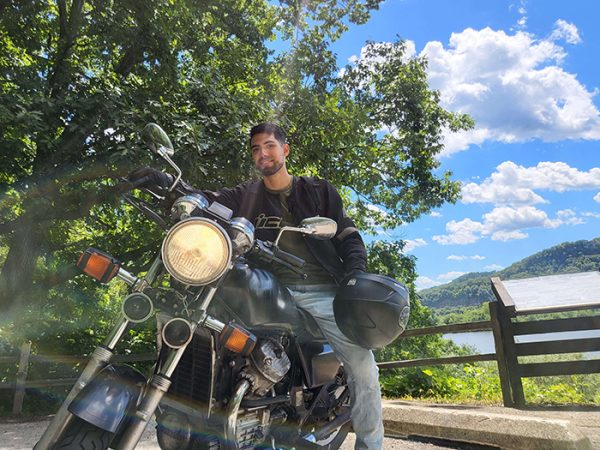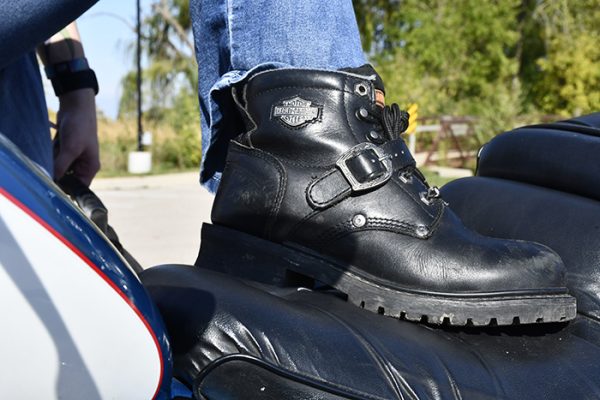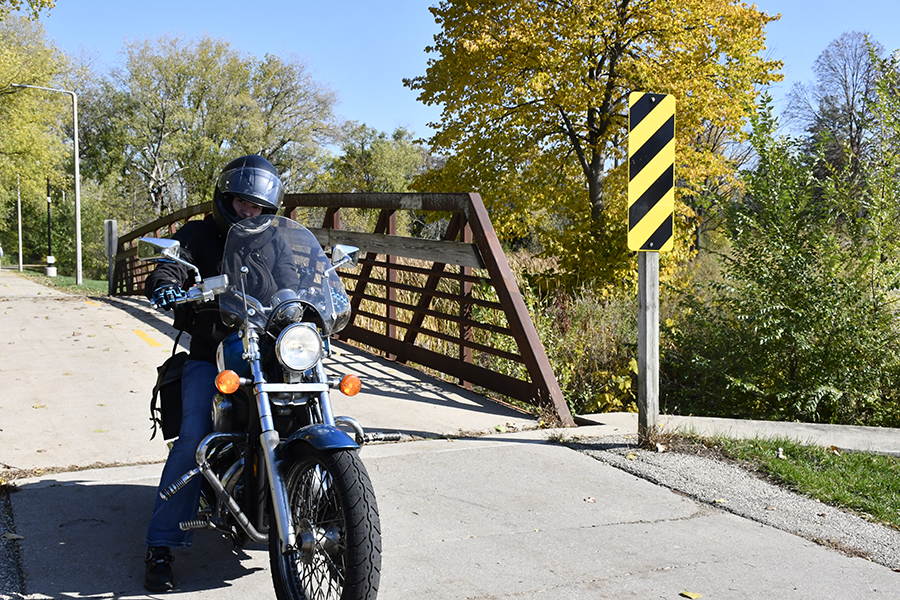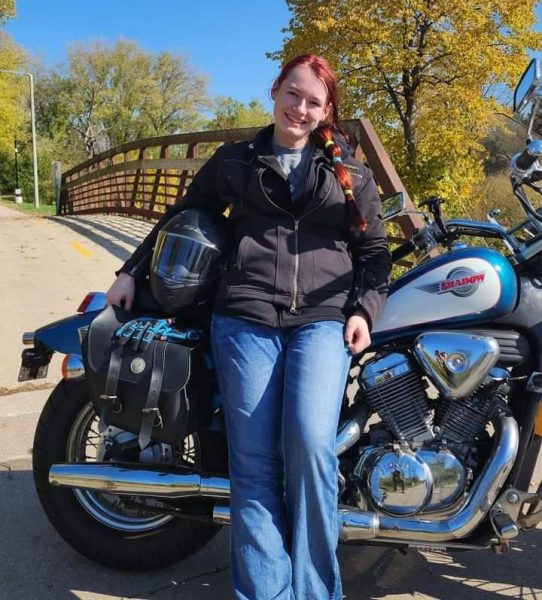From as early as April and as late as October, students and community members alike can sign up for a motorcycle safety Basic Motorcycle Rider Course at Madison College. The course is co-taught by Lauranne Bailey and Jason Herheim, certified by the Motorcycle Safety Foundation and approved by the Wisconsin Department of Transportation (WisDOT).
The course prepares students to get a Class M motorcycle license via WisDOT. Taking the course is required to obtain the license, along with passing a road test.
Madison College Accounting program student Jade Baker completed both of those tasks in October 2022, receiving her motorcycle license so she could get out on the open road.
A family legacy of motorcycle riders
Motorcycles have played a significant role in Baker’s life since her parents are both bikers. The earliest documented photo of her was when she was nine months old and the first time she ever rode on a motorcycle was at six years old.
After Baker acquired her license, Baker purchased her 500-pound beauty “Iris,” a 1994 Honda Shadow VLX cruising motorcycle (or “cruiser”) with a 600cc engine. Though some others refer to her bike as “Baby Beep Beep” for two reasons: 1) her mom has a Honda cruiser which would make hers the baby version and 2) the horn sounds off a two-part “beep beep” when pressed.
The bike cost about $600 to purchase and about $1,400 for engine maintenance, for a total price tag of about $2,000. Additionally, she bought safety gear such as a three-quarters face or full faced helmet, eye protection fingered gloves, body protection, a jacket to cover the arms, and boots, which could run someone around $300-$500 depending on the quality of the helmet.
But after she got all the required safety equipment, Baker was ready to ride. She says being on the open road gives her the “freedom of wind therapy” to invigorate her life. She tries to ride her bike as much as she can, especially in the late summer and early fall when the weather offers the most relaxing rides on Wisconsin back roads.
“It feels like nothing else in the world matters, like you’re in your own little world and can forget about all your struggles,” Baker described. “A lot of the times when I’m riding, I don’t have a destination. I literally just set out and turn when I feel like turning.”

Mechanical design and the art of motorcycle maintenance
For Steve Reyes, motorcycle ownership became an opportunity for some practical application of his engineering studies. He moved from La Crosse to Madison just this year and began the Engineering Liberal Arts Transfer program at Madison College.
Initially, Reyes was aiming to live out his childhood dreams of finally being independent and riding his own motorcycle. But on a more practical level he saw a motorcycle as a cheap way to get back on wheels without breaking the bank.
He got his first bike, a Kawasaki Ninja 250R, about seven years ago, but that didn’t last long when he slipped on an icy railroad track and totaled it. His second bike was an upgraded Kawasaki Ninja 300 which lasted him much longer, and now he plans to do his own maintenance on his 1982 Honda GL500 Silver Wing, which he plans on modding into a café racer. His current bike cost him just over $1,000 for the bike along with registration fees and he is prepared to sink more money in to make the necessary modifications.
“This bike is different because now I can build it into something completely new,” Reyes proclaimed. “These project bikes tend to be not just bikes that you ride around for fun, but like a means of creative expression.”
Reyes said that his Introduction to Engineering class taught by Madison College Professor John Grade helped solidify the fundamental theory behind electrical engines. In that class, one of the projects was to dissect an eggbeater, which he learned was essentially just an electric motor bolted to a clip-on egg whisk. From that experience, he gained the confidence to learn more about the starter motor in the bike and begin his own basic bike maintenance.
Grade strives to provide students with hands-on experience working directly on issues that they would encounter in a work environment. In fact, the course is co-taught with Madison College instructor Jon Christian, who owns and operates an automotive repair shop.
“Probably the clearest way that we engage students with real-world applications is by having student teams work together to design and fabricate prototype solutions that solve actual industrial challenges faced by local companies,” Grade said.
And Grade affirmed the excitement and engagement that Reyes has for the creative design projects he has planned for the semester. Overall, Reyes says he feels more equipped to solve any issues that come up with his bike because he knows he has the tools to figure it out on his own.
“Schooling day one made me equipped to actually solve any problems with my motorcycle,” Reyes stated. “Now I’m going to completely disassemble it and get it up and running perfectly so I can build that racer.”

Motorcyclists must always be alert
Sometimes Reyes feels wary about riding his motorcycle along with the standard traffic. He intimately understands the potential dangers of winding up in an accident as a motorcyclist.
Before he moved to Madison, he was visiting the area and almost got hit by a woman in a minivan, who narrowly swerved to avoid him as he was driving up a hill. And Reyes had previously totaled his bicycle during the winter from a mere inconveniently placed ice patch near a railroad track.
According to the National Highway Traffic Safety Administration’s Fatality Analysis Reporting System, from 2012-2021 there have been 51,384 motorcycle fatalities with 5,932 occurring in 2021. Wisconsin ranks as the 6th most dangerous state for motorcyclists with 922 fatalities involving motorcyclists.
Crashes are just as likely to happen during daytime as nighttime, more crashes happen during the summer (37%), mostly males perish in crashes (91%) and most of the fatal crashes occurred between the age groups 21-59.
Similar to Reyes, Baker also agrees that general traffic doesn’t pay enough respect to motorcyclists. But she also cautions motorcycle riders to avoid flashy maneuvers in traffic because they are often riskier and can lead to dangerous, and sometimes even fatal, outcomes.
“This might be an unpopular opinion, but people on motorcycles need to take their own safety into account as well,” Baker elaborated. “There just needs to be a lot more safety in general when it comes to motorcycles that way everyone stays safe, and we can focus on enjoying the ride.”
And perhaps the number of fatalities and general danger vibe of motorcycles lend credit to the culture of superstition within the biker community. For example, a commonly held belief amongst bikers is that of the guardian bell, or spirit bell, to ward off evil spirits. Baker actually has a bell attached to her frame, which gives her good luck as she travels on the open roads. But even without a bell, her defensive driving techniques and high level of caution will keep her safe as a Wisconsin motorcyclist.



























